Blood pressure gradients and cardiovascular risk factors in urban and rural populations in Abia State South Eastern Nigeria using the WHO STEPwise approach
Date
2013Author
Okpechi, Ikechi Gareth
Chukwuonye, Innocent Ijezie
Tiffin, Nicki
Madukwe, Okechukwu Ojoemelam
Onyeonoro, Ugochukwu Uchenna
Umeizudike, Theophilus Ifeanyichukwu
Ogah, Okechukwu Samuel
Onyeonoro, Ugochukwu Uchenna
Metadata
Show full item recordAbstract
Background: Developing countries of sub-Saharan Africa (SSA) face a double burden of non-communicable diseases (NCDs)
and communicable diseases. As high blood pressure (BP) is a common global cardiovascular (CV) disorder associated with
high morbidity and mortality, the relationship between gradients of BP and other CV risk factors was assessed in Abia State,
Nigeria.
Methods: Using the WHO STEPwise approach to surveillance of chronic disease risk factors, we conducted a populationbased
cross-sectional survey in Abia state, Nigeria from August 2011 to March 2012. Data collected at various steps
included: demographic and behavioral risk factors (Step 1); BP and anthropometric measurements (Step 2), and fasting
blood cholesterol and glucose (Step 3).
Results: Of the 2983 subjects with complete data for analysis, 52.1% were females and 53.2% were rural dwellers. Overall,
the distribution of selected CV disease risk factors was diabetes (3.6%), hypertension (31.4%), cigarette smoking (13.3%), use
of smokeless tobacco (4.8%), physical inactivity (64.2%) and being overweight or obese (33.7%). Presence of hypertension,
excessive intake of alcohol, smoking (cigarette and smokeless tobacco) and physical inactivity occurred more frequently in
males than in females (p,0.05); while low income, lack of any formal education and use of smokeless tobacco were seen
more frequently in rural dwellers than in those living in urban areas (p,0.05). The frequency of selected CV risk factors
increased as BP was graded from optimal, normal to hypertension; and high BP correlated with age, gender, smokeless
tobacco, overweight or obesity, annual income and level of education.
Conclusion: Given the high prevalence of hypertension in this part of Nigeria, there is an urgent need to focus on the
reduction of preventable CV risk factors we have observed to be associated with hypertension, in order to effectively reduce
the burden of NCDs in Africa.

